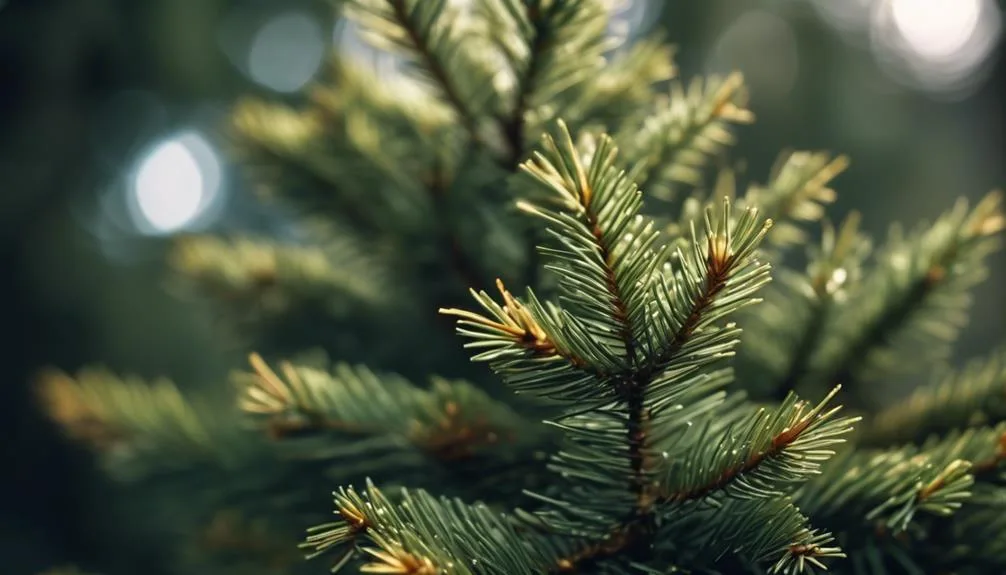Your spruce tree, once lush and green, now appears brown and lifeless. It's natural to feel puzzled and worried about this change. Several factors could be causing this, and understanding them is essential to reviving your tree's health.
Let's explore the reasons behind your spruce tree's brown appearance, so you can take the necessary steps to restore its vibrancy.
Common Causes of Spruce Tree Browning
If you notice your spruce trees browning, it's essential to understand the common causes behind this issue to effectively address it.
One common cause of spruce tree browning is the soil composition. Spruce trees thrive in well-drained, acidic soil. If the soil is too alkaline or compacted, it can lead to poor root growth and nutrient uptake, resulting in browning of the needles.
Another factor to consider is the watering frequency. Overwatering or underwatering can both contribute to browning. Too much water can lead to root rot, causing the needles to turn brown, while underwatering can lead to stress and dehydration.
It's crucial to ensure the soil has good drainage and to water the spruce trees consistently, allowing the soil to dry slightly between waterings to prevent browning.
Environmental Stress Factors
When it comes to environmental stress factors affecting spruce trees, changes in temperature and humidity levels can significantly impact their health and lead to browning of the needles. Climate change and pollution can create drastic shifts in weather patterns, exposing spruce trees to extreme conditions that they may not be able to adapt to quickly.
Soil compaction and root damage, often caused by construction or heavy foot traffic, can disrupt the tree's ability to absorb nutrients and water, leading to stress and browning. Additionally, pollutants in the air and soil can directly harm the tree, affecting its overall health and causing needle discoloration.
Being mindful of these environmental stress factors and taking steps to mitigate their impact can help in maintaining the vitality of your spruce tree.
Pests and Diseases Impacting Spruce Trees
Pests and diseases can wreak havoc on the health of your spruce trees, causing damage to the foliage and compromising the overall vitality of the tree. Two common issues impacting spruce trees are fungal infections and insect infestations. Fungal infections such as needle cast and rust can lead to browning and premature shedding of needles. Insect infestations, particularly by spruce spider mites and adelgids, can cause discoloration and stunted growth. Implementing proper tree care and prevention strategies is crucial to combat these threats. Regularly inspect your trees for signs of infestation or infection, and consider applying fungicidal treatments and insecticides as preventive measures. Ensuring proper watering, adequate spacing, and good air circulation around the trees can also help in preventing these issues.
| Fungal Infections | Insect Infestations | Prevention Strategies |
|---|---|---|
| Needle cast | Spruce spider mites | Regular tree inspection |
| Rust | Adelgids | Fungicidal treatments |
| Proper tree care |
Cultural and Maintenance Issues
Dealing with the cultural and maintenance issues of your spruce trees is vital for ensuring their long-term health and vitality, especially in the face of potential threats from pests and diseases. To maintain the vigor of your spruce trees, it's important to focus on cultural practices and watering schedules.
- Cultural Practices
- Proper pruning to maintain good air circulation and reduce the risk of fungal diseases.
- Regularly inspecting for signs of stress or disease, such as discoloration and abnormal growth.
- Ensuring adequate spacing between trees to prevent overcrowding and competition for resources.
Remedies for Restoring Spruce Tree Health
To restore the health of your spruce trees, it's essential to implement targeted remedies that address any existing issues and promote their overall well-being. Consider using natural remedies and incorporating proper watering techniques to revitalize your trees. Here are some effective strategies:
| Natural Remedies | Proper Watering Techniques |
|---|---|
| Neem oil spray | Deep watering |
| Compost or organic mulch | Mulching |
| Beneficial nematodes | Watering in the morning or evening |
| Pruning of affected areas | Avoiding frequent shallow watering |
| Epsom salt solution | Using soaker hoses or drip irrigation |
Conclusion
As you nurture and care for your spruce tree, remember to address any environmental stress, pests, diseases, or maintenance issues promptly.
By doing so, you can witness the vibrant green needles return, restoring your spruce tree to its thriving state.
Stay vigilant and attentive to your tree's needs, and with proper care, its health and beauty will be rejuvenated.

My interest in trees started when I first saw the giant sequoias in Yosemite.
I was a teenager then, and I remember thinking, “I need to learn more about this.”
That moment stuck with me.
A few years later, I went on to study forestry at Michigan Tech.
Since graduating, I’ve worked in a mix of hands-on tree care and community education.
I’ve spent over ten years helping people understand how to plant, maintain, and protect the trees in their neighborhoods.
I don’t see trees as just part of the landscape.
They are living things that make a real difference in our daily lives.
